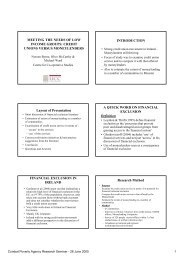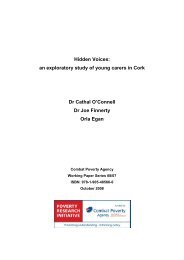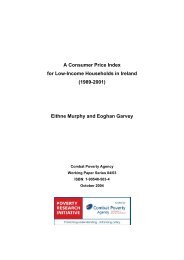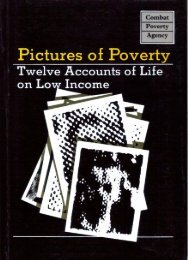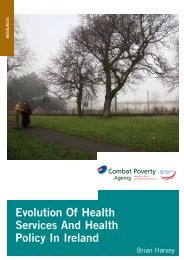The Distribution of Income in Ireland (2000) - Combat Poverty Agency
The Distribution of Income in Ireland (2000) - Combat Poverty Agency
The Distribution of Income in Ireland (2000) - Combat Poverty Agency
- No tags were found...
You also want an ePaper? Increase the reach of your titles
YUMPU automatically turns print PDFs into web optimized ePapers that Google loves.
Appendix 1Decomposition <strong>of</strong> Total Household<strong>Income</strong> Inequality by FactorComponents, 1987-1994Chapter 7 made reference to results from the disaggregation <strong>of</strong>total household <strong>in</strong>come <strong>in</strong>to its <strong>in</strong>dividual components <strong>in</strong> orderto identify the effect <strong>of</strong> wives earn<strong>in</strong>gs and employment on <strong>in</strong>equality.This appendix sets out the details <strong>of</strong> the decompositionmethodology employed and the results. 1<strong>The</strong> issues associated with decompos<strong>in</strong>g total <strong>in</strong>equality by<strong>in</strong>come components are exam<strong>in</strong>ed <strong>in</strong> Shorrocks (1982a,b). Heshows that by appropriate choice <strong>of</strong> a weight<strong>in</strong>g function onecan f<strong>in</strong>d alternative decompositions <strong>of</strong> a given <strong>in</strong>equality <strong>in</strong>dexwhich yield vastly different conclusions concern<strong>in</strong>g the importance<strong>of</strong> a given component. In fact, the contribution <strong>of</strong> anyfactor expressed as a proportion <strong>of</strong> total <strong>in</strong>equality can bemade to take any value between plus and m<strong>in</strong>us <strong>in</strong>f<strong>in</strong>ity. Furthermore,he shows that there are no strong statistical reasonsfor choos<strong>in</strong>g any one <strong>of</strong> these decompositions over the other.Shorrocks argues that a potential means <strong>of</strong> choos<strong>in</strong>g betweenthe multiplicity <strong>of</strong> outcomes is to focus on what is normallymeant by statements <strong>of</strong> the form "factor X contributes Z percent<strong>of</strong> total <strong>in</strong>equality".Canican and Reed (1998) develop this idea further by compar<strong>in</strong>gtwo common <strong>in</strong>equality <strong>in</strong>dices, the coefficient <strong>of</strong> variationand the G<strong>in</strong>i coefficient. <strong>The</strong>y argue that the standard de-1 For other studies us<strong>in</strong>g a similar approach to exam<strong>in</strong><strong>in</strong>g <strong>in</strong>come» "J^JjJJsee Layard and Zabalza (1979), Canican, Danz<strong>in</strong>ger and Gottschalk (1993)and Mach<strong>in</strong> and Waldfogel (1994).




